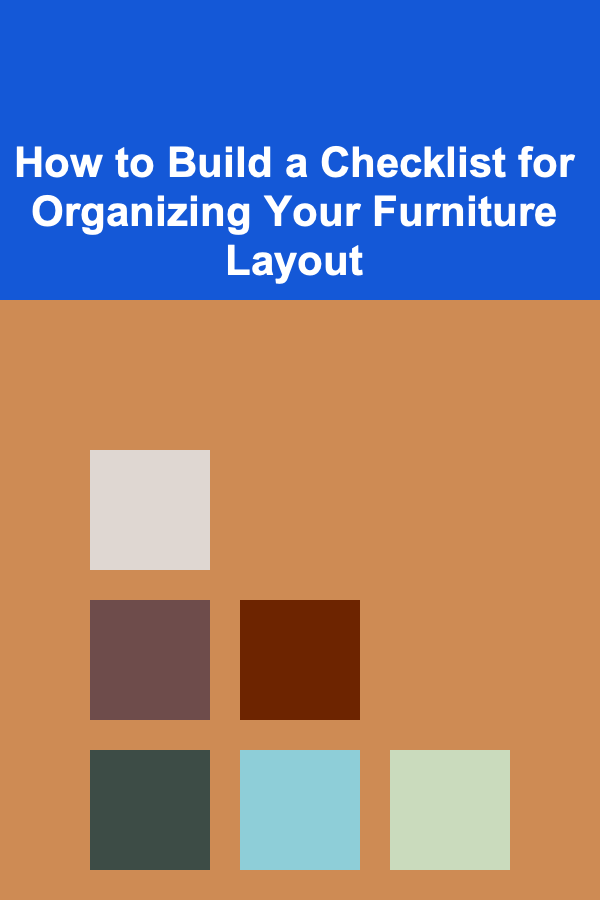
How to Build a Checklist for Organizing Your Furniture Layout
ebook include PDF & Audio bundle (Micro Guide)
$12.99$9.99
Limited Time Offer! Order within the next:

When it comes to interior design, one of the most important yet often overlooked aspects is the furniture layout. The way you arrange your furniture can influence the functionality, flow, and overall ambiance of a room. Whether you're moving into a new home, redecorating an existing space, or simply looking to refresh a room, a well-thought-out furniture layout can make a world of difference.
In this guide, we'll break down the key steps to building a comprehensive checklist for organizing your furniture layout. This checklist will help you maximize space, improve functionality, and ensure that your furniture complements the room's aesthetic.
Step 1: Define the Room's Purpose
Before you start shifting furniture around, it's important to understand the purpose of the room. The layout should be designed around the way the space will be used, ensuring it meets your needs and enhances your daily activities.
Key Considerations:
- Primary Function: What will the room be primarily used for? Is it a living room for relaxation, a dining area for meals, or a home office for work?
- Activities: Think about the activities that will take place in the space. For example, if it's a living room, will you watch TV, entertain guests, or read books there?
- Multi-Functionality: If the room serves multiple purposes (like a guest bedroom that doubles as an office), ensure your layout allows for flexibility.
Checklist for Room Purpose:
- Identify the primary function of the room.
- Make a list of secondary activities that will take place.
- Determine how flexible the room needs to be (for example, can the space transform for different uses throughout the day?).
Step 2: Measure Your Space
Accurate measurements are the foundation of a successful furniture layout. Before you start moving heavy pieces around, make sure you know the size of the room and the dimensions of your furniture.
Key Considerations:
- Room Dimensions: Measure the length, width, and height of the room, including any alcoves or extensions. Don't forget to account for windows, doors, and built-in elements like fireplaces.
- Furniture Dimensions: Measure the width, depth, and height of each piece of furniture you plan to use in the space. Consider the shape of the furniture---rectangular pieces, like sofas and desks, will require different layouts than round or modular pieces.
- Traffic Flow: Account for walkways between furniture pieces. Ensure that there's enough space to move comfortably around the room, and that the layout doesn't feel cramped.
Checklist for Measurements:
- Measure the dimensions of the room (length, width, and height).
- Measure the size of each piece of furniture.
- Take note of windows, doors, and other architectural features.
- Leave enough room for traffic flow---at least 2-3 feet of space between furniture and walls.
Step 3: Plan for Functionality
Once you've measured the space and determined the room's purpose, the next step is to think about functionality. Your layout should prioritize ease of movement, accessibility, and comfort. The arrangement of furniture should make it easy to use the space as intended, without creating barriers or awkward configurations.
Key Considerations:
- Traffic Flow: Arrange your furniture in a way that allows for natural movement through the space. Avoid blocking doorways or creating obstacles in high-traffic areas.
- Accessibility: Ensure that all furniture is easily accessible. This includes making sure that seating areas are not blocked and that everything can be reached without difficulty.
- Functional Zones: In larger rooms or multi-functional spaces, create distinct zones for different activities. For example, in a living room, you might have a TV viewing zone, a reading nook, and a conversation area.
Checklist for Functionality:
- Avoid blocking key entryways or walkways.
- Create functional zones if needed (e.g., seating area, workspace, dining area).
- Ensure that all furniture is accessible and not overcrowded.
- Plan for easy access to frequently used items, like side tables or lamps.
Step 4: Focus on Aesthetics and Style
The furniture layout isn't just about functionality---it also plays a huge role in the overall aesthetic of the room. The way furniture is arranged can impact how a room feels, both in terms of mood and visual appeal.
Key Considerations:
- Focal Point: Every room should have a focal point---a central feature that draws attention. In a living room, this might be the TV, a fireplace, or a large window with a beautiful view. Arrange your furniture around this focal point to create harmony.
- Balance and Proportion: Ensure that the size and scale of your furniture are proportionate to the size of the room. Avoid overcrowding a small room with large furniture or placing tiny pieces in a spacious room.
- Style Consistency: The layout should complement the room's overall design style. Whether your space is modern, traditional, eclectic, or minimalist, the furniture should align with the aesthetic.
Checklist for Aesthetics:
- Identify the room's focal point and arrange furniture around it.
- Balance large and small furniture pieces to create proportionate visual appeal.
- Ensure that the furniture style complements the room's overall aesthetic.
- Use symmetry or asymmetry to create a visually pleasing layout.
Step 5: Consider Lighting and Natural Light
Lighting plays an essential role in the furniture layout, not only for ambiance but also for practical purposes. A well-lit room can make the space feel more open and inviting, while poor lighting can create a gloomy or cramped atmosphere.
Key Considerations:
- Natural Light: Take advantage of windows and natural light sources. Avoid placing large furniture pieces in front of windows unless it's for aesthetic purposes, like framing the view.
- Task Lighting: In areas where you'll be performing tasks, such as reading or working, position your furniture so that it gets adequate task lighting.
- Ambient Lighting: Ensure the room has enough ambient light to create a comfortable environment. Layer different types of lighting (overhead, task, and accent) for a balanced effect.
Checklist for Lighting:
- Avoid blocking natural light by placing furniture in front of windows.
- Position task-oriented furniture (like desks or reading chairs) near appropriate light sources.
- Incorporate ambient lighting for overall illumination.
- Use accent lighting to highlight key design features or artwork.
Step 6: Maximize Storage and Organization
An effective furniture layout also considers how to optimize storage space. Organizing your furniture in a way that allows for efficient storage can help keep the room clutter-free and functional.
Key Considerations:
- Built-In Storage: If possible, incorporate furniture with built-in storage solutions, such as ottomans with hidden compartments or coffee tables with drawers.
- Vertical Space: Don't forget to use vertical space for storage. Tall bookshelves, wall-mounted shelves, or hanging storage can free up floor space while keeping items within reach.
- Hidden Storage: Consider hidden storage options, like storage benches or hidden cabinets, that help maintain a clean and uncluttered look.
Checklist for Storage:
- Include furniture with built-in storage, if possible.
- Utilize vertical space with shelves or wall-mounted storage.
- Keep everyday items within easy reach but out of sight.
- Avoid overcrowding the room with unnecessary items.
Step 7: Test and Adjust the Layout
Once you've finalized your furniture arrangement, it's time to test it out. Live with the layout for a few days and observe how it feels. Sometimes, even the best-planned layouts may require minor adjustments based on how the space is used in real life.
Key Considerations:
- Comfort: After living in the space for a bit, reassess the comfort of the layout. Are you able to move freely? Is there enough seating for guests? Is there a comfortable balance of light and shade?
- Adjustments: If the layout doesn't feel right, don't be afraid to make adjustments. Small tweaks, like shifting a piece of furniture slightly or swapping the position of two items, can often lead to a more comfortable and functional layout.
Checklist for Testing:
- Spend time in the space to see how the layout feels.
- Adjust the furniture if needed to improve comfort or traffic flow.
- Reassess storage and lighting to ensure they are functional.
- Make any minor tweaks to optimize the layout further.
Conclusion
Organizing your furniture layout is more than just arranging pieces in a room---it's about creating a space that is both functional and aesthetically pleasing. By following this actionable checklist, you can ensure that your layout maximizes space, enhances comfort, and reflects your personal style. Don't rush the process---take the time to plan, measure, and test different arrangements. With a little effort and attention to detail, you can create a space that you'll love to spend time in.
Reading More From Our Other Websites
- [Star Gazing Tip 101] How to Record Accurate Timing Data for Variable Star Brightness Changes Using a DSLR
- [Organization Tip 101] DIY Stair Tread Replacement: A Beginner's Guide
- [Biking 101] Bike Hydration 101: Best Practices for Staying Cool and Fueled
- [Metal Stamping Tip 101] Material Matters: Selecting the Right Alloys and Sheet Thickness to Minimize Stamping Spend
- [Scrapbooking Tip 101] Best Ways to Integrate QR Codes Linking to Video Memories Within Pages
- [Screen Printing Tip 101] Budget‑Friendly Tips to Set Up a Home Screen‑Printing Studio
- [Home Soundproofing 101] How to Soundproof Your Windows for a Peaceful Home Environment
- [Home Party Planning 101] How to Plan the Ultimate Movie Night Party at Home
- [Organization Tip 101] How to Use Pet Gates to Define Spaces Effectively
- [Organization Tip 101] When to Use a Jigsaw vs. a Circular Saw for Home Renovations

How to Craft a Communication Checklist for Software Implementation
Read More
How to Store Kitchen Appliances Out of Sight
Read More
How to Use Budgeting Charts and Graphs for Visualization
Read More
How to Use Color Coding for Vintage Collections
Read More
How To Create a Simple Budgeting System for FIRE
Read More
Painting Seascapes and Water: A Deep Dive
Read MoreOther Products

How to Craft a Communication Checklist for Software Implementation
Read More
How to Store Kitchen Appliances Out of Sight
Read More
How to Use Budgeting Charts and Graphs for Visualization
Read More
How to Use Color Coding for Vintage Collections
Read More
How To Create a Simple Budgeting System for FIRE
Read More